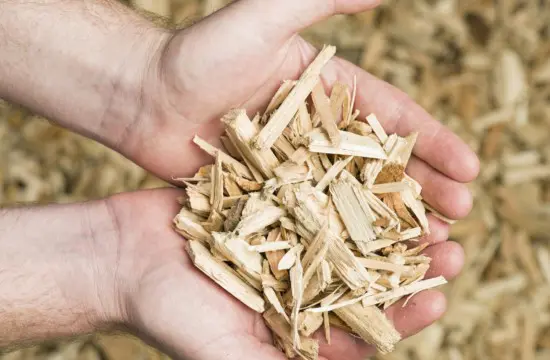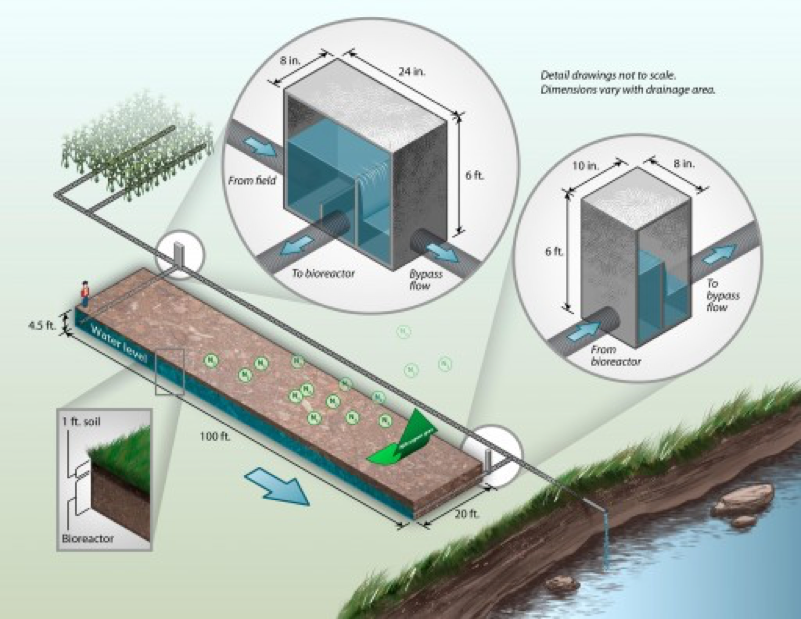States across the Midwest are working with federal regulators to set targets for minimizing nitrogen (N) pollution from agriculture. These states are implementing science- and technology-based frameworks, like the Iowa Nutrient Reduction Strategy, that call for installing thousands of denitrifying bioreactors to help reduce nutrient runoff into waterways.
Over the past five years, a number of bioreactors have been installed throughout the Midwest improving agriculture’s impact on more than 38 million acres of tile drainage in the Corn Belt states.
This edge-of-field practice was built into the Iowa Nutrient Reduction Strategy after a scientific assessment of nonpoint sources by the Iowa Department of Agriculture and Land Stewardship and the College of Agriculture and Life Sciences at Iowa State University. The objective of the Iowa Nonpoint Source Nutrient Reduction Science Assessment was to identify and model the effectiveness of specific practices at reducing N and phosphorus (P) from reaching the Gulf of Mexico, plus estimating the total cost and per unit cost of nutrient removed when implementing a practice.
Water passes from the tile system into the bioreactor with denitrifying bacteria converting nitrate contained in the tile water into di-nitrogen gas. By this method, water quality is improved throughout this system by reducing the nitrate-N content of subsurface agricultural drainage flow.
So what is a denitrifying bioreactor?
On the surface, bioreactors are man-made soil trenches lined in clear plastic and filled with a carbon-source. Bioreactors are leveled to the surface of the land and work cohesively with a tiling system.
A number of carbon-source materials, such as corn cobs, corn stalks, wheat straw, cardboard and newspaper, have been investigated, but research has recommended woody material because it provides a sustainable, longer-lasting source of carbon.
Within these bioreactors, microorganisms from the soil colonize the woodchips as the tile water flows through the bioreactor before entering another body of water. These microorganisms “eat” the carbon from the woodchips and “breathe” the nitrate from the water. Just as humans breathe in oxygen and breathe out carbon dioxide, these microorganisms breathe in nitrate and breathe out harmless nitrogen gas. The gas exits the biofilter and into the atmosphere, naturally making up for more than three-fourths of the air we breathe.
Bioreactors are designed strategically to optimize retention time and maximize nitrate removal without undesirable by-products.
One of the largest benefits of bioreactors is they typically require no land to be removed from agricultural production. They fit well in edge-of-field, grassed buffer areas. However, consideration needs to be given to issues including space availability, soil type and quality of terrain. It is also preferable to have a good understanding of the drainage system (drain size, slope and location) so the bioreactor can be designed more accurately. Bioreactors are intended to be implemented on a farm scale treating up to 100 acres of tile-drained land.
What’s Happening in the Soil
Denitrification is the conversion of nitrate (NO3) to nitrogen gas (dinitrogen, N2) that is carried out by bacteria living in soils all over the world and in the bioreactor. Because these bacteria can breathe oxygen, providing anaerobic conditions through more constantly flowing tile water helps ensure the bacteria utilize the nitrate.
Because this is a biological process, nitrate removal can be negatively impacted by cooler water temperatures or flow rates that are too high. However, high flow rates and the corresponding low retention time the water experiences with the bioreactor can be managed to some extent by working with the control structures.
A study by Iowa State Extension and Outreach looked at four bioreactors in Iowa, showing an average nitrate-N reduction of 43 percent for water going through the bioreactor. These systems can be designed with higher removal rates, up to 50 percent of nitrate-N load coming from a tile drainage system by maximizing retention time and minimizing bypass flow. Like wetlands, the larger a bioreactor is the more potential for nitrate-N reduction. However, there are concerns with over-designed systems as the denitrifying bacteria can produce methylmercury, which is highly toxic and can lead to bioaccumulation in fish.
Bioreactors are heavily dependent on design, and could be sized to remove up to 50% or more of the nitrate load from a tile line. However, preliminary research in Iowa shows an average nitrate reduction of 43 percent from one study using the mean calculation procedure (mean = 1 – ((2+4)/2)/((6+8)/2)) = 0.27 or 57 percent).
In some locations, the use of bioreactors can work hand in hand with water table management to further reduce nutrient loading and provide water management during drought conditions. Water table management makes use of a control structure, such as a bioreactor, to manage the level of water above the tile line. Bioreactors contain a method of controlled drainage which can be used to raise and lower the water table, depending on the time of year and water needs. This practice can be used to raise the water level after harvest, reducing nitrogen loading into surface waters. It can also allow higher water levels to be present if needed during the dry growing season.
Research and Implementation
This edge-of-field practice targeted for water quality benefits subsurface drainage bioreactors by showing the greatest potential for nitrate-N reduction. The potential for nitrate-N reductions for controlled drainage are limited by land area application for this practice (slopes less than 1 percent).
Bioreactor installation and maintenance cost estimates include control structures, design, woodchips, construction, seeding, additional tile, management and maintenance. The example used in research was based on a 0.25 acre bioreactor with a 50-acre treatment area. The resulting equal annualized cost was $10.23/treated acre per year with a net present value cost of $220/treated acre.
As with any farming practice, there are limitations, concerns or considerations to address such as:
- The practice is limited to tile drained landscapes;
- Woodchip availability for the systems;
- Installing many bioreactors in a short period of time or replacing all woodchips at the same time would increase costs and affect the system;
- Additional industry (timber/woodchips) development due to demand; and
- Contractor availability could limit rapid installations.
Most installations in the Midwest to date have been approximately 100 to 120 feet long by 10 to 25 feet wide. The bioreactors fit well in edge-of-field buffer strips and grassed areas.
For these systems, type and size of woodchip matters. Not all woodchips are cut equally. Allowing chips that have fine materials, shredded materials, dirt or gravel can change the rate of water flow, meaning the bioreactor may not work as intended.
A majority of the chips used in bioreactor research range from ¼-inch to 1-inch in size. Chips from treated and preserved wood are not recommended as this limits the bacteria’s ability to use the carbon on the wood. Including green materials such as leaves and conifer needles is not recommended due to their relatively high nitrogen content.
Research has estimated bioreactor lifespans of 15 to 20 years, after which the woodchips would be replaced if treatment was to be continued. Because it is a new practice, no bioreactors have been in the ground long enough to have direct evidence of longevity. The oldest working denitrification system that treats tile wastewater was 15 years old in 2010.
It is critical to have a research-based understanding of how well bioreactors work before they can be considered beyond the demonstration phrase. Although bioreactors typically require no modification of current in-field practices and little annual maintenance, they may qualify for USDA conservation cost share assistance through the Conservation Stewardship Program and the Environmental Quality Incentives Program to assist with the cost of woodchips and excavation.



